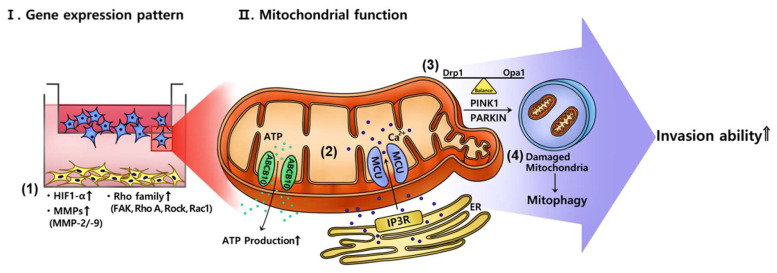Figure 6.
Schematic illustration of the current working hypothesis. The gene expression pattern (I) showed that PD-MSCs improve trophoblast invasion via various gene expression. (1) PD-MSCs trigger trophoblast invasion via upregulating HIF1α and activating MMPs and the Rho family signaling pathway. The mitochondrial function (II) indicated that PD-MSCs regulate dynamic mitochondrial function including ATP synthesis, calcium transfer and mitophagy in invaded trophoblast cells. (2) PD-MSCs regulate the mitochondrial function of invasive trophoblasts. Particularly, the mRNA expression of both MCU and IP3R, transporters that move calcium ions though the mitochondria and ER, is upregulated in invasive trophoblasts. Additionally, PD-MSCs increase the mRNA expression of ABCB10, which is involved in ATP production, in invasive trophoblasts. (3) PD-MSCs regulate mitochondrial fragmentation via maintaining the balance between fission and fusion in trophoblasts. (4) PD-MSCs trigger mitochondrial autophagy in trophoblasts via upregulating PINK1 and PARKIN expression. Finally, PD-MSCs promote trophoblast invasion via regulating mitochondrial dynamics, including ATP production and mitochondrial autophagy. PD-MSCs: Placenta-derived mesenchymal stem cells; HIF-1a: Hypoxia inducible factor 1 alpha; MMP: Matrix metalloproteinase; ATP: Adenosine triphosphate; mRNA: messenger RNA; MCU: Mitochondrial calcium uniporter; IP3R: Inositol 1,4,5-trisphosphate; ER: Endoplasmic reticulum; ABCB10: ATP binding cassette subfamily B 10; PINK1: PTEN-induced kinase 1; PARKIN: parkin RBR E3 ubiquitin protein ligase

